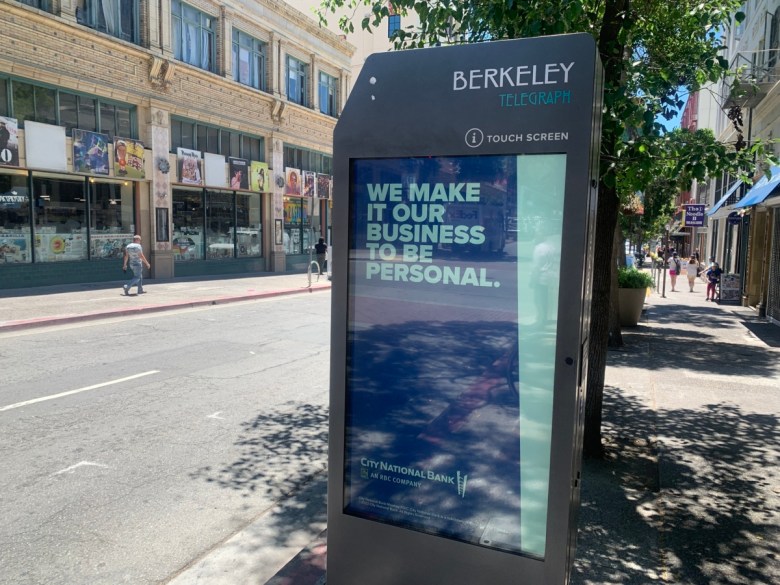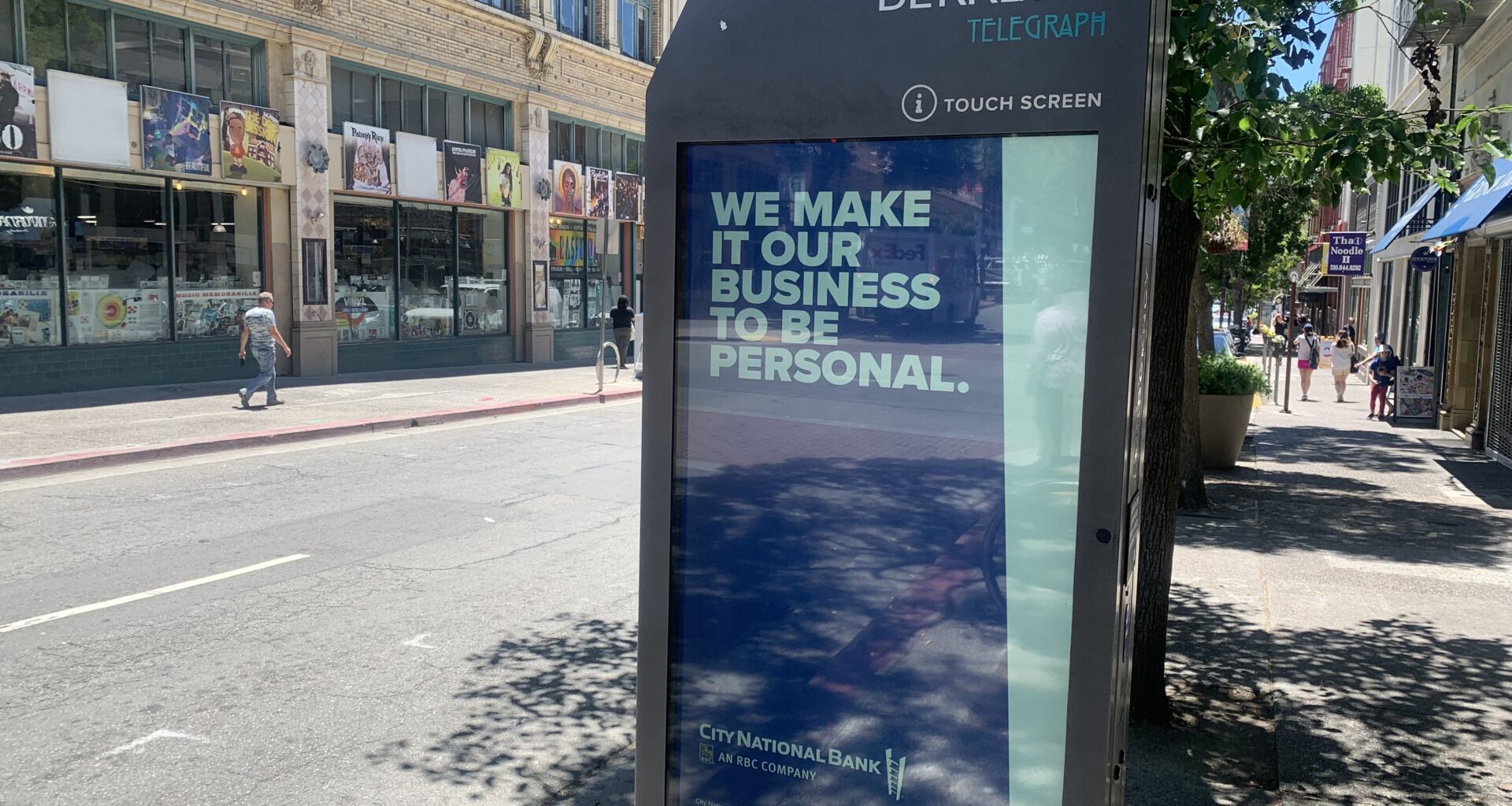 An IKE Smart City kiosk on Telegraph Avenue displays an advertisement for City National Bank. Credit: Nico Savidge
An IKE Smart City kiosk on Telegraph Avenue displays an advertisement for City National Bank. Credit: Nico Savidge
When an advertising firm sought approval in 2018 for a deal to plant touch-screen video kiosks on Berkeley’s sidewalks, it claimed the city would receive nearly $830,000 per year in proceeds from ads displayed on the devices. The company, Orange Barrel Media, told the city that each of its IKE Smart City kiosks would generate more than $26,000 annually in revenue for Berkeley.
Seven years later, however, the kiosks haven’t come close to meeting those lofty projections, Berkeleyside has learned.
Berkeley has instead received just $75,000 per year from the kiosk program in the three years the devices have been active. That’s due in part to a slow roll-out of the kiosks. But the devices also have not generated nearly as much money as Orange Barrel Media claimed they would when the City Council signed off on a 15-year contract with the company.
Each kiosk generated $4,967 on average across 2024 — less than one-fifth of the company’s 2018 projections, without taking inflation into account. Even that figure overstates how profitable the devices are, since the $75,000 the city received was the minimum amount guaranteed under its contract. Without that minimum, Berkeley would have gotten an average of $1,997 per kiosk, according to revenue statements from the company.
Meanwhile, other cities have signed contracts with Orange Barrel Media in recent years guaranteeing they will receive much more revenue than Berkeley has been paid.
Officials from Orange Barrel Media, the city of Berkeley and Visit Berkeley — the tourism bureau that also receives a share of advertising revenue generated by the kiosks — all declined interview requests for this story.
But in written responses to questions from Berkeleyside, Orange Barrel Media Senior Development Director Clay Collett blamed the revenue figures on the Bay Area’s slow economic recovery from the pandemic and a technology sector that has cooled significantly since the company made its projections.
“It’s simply a different market than it was pre-COVID, and we’re all doing as much as we can to try and improve performance,” Collett wrote. “The Bay Area, and the technology sector, looked very different back in 2018, and the reality is that there is less advertising demand in the Bay Area than there was before COVID.”
In their own emailed statements, city and Visit Berkeley officials backed up the company’s stance that the pandemic explains the gap between the projected and actual revenue from the kiosks.
They also maintain that the touch-screen devices provide a valuable service to the public, since they contain maps and business directories that can help people get around Berkeley and discover local merchants. The devices are installed and maintained by Orange Barrel Media at no cost to the city, and the company provides free or discounted advertising to local nonprofits and businesses.
“OBM has honored their commitment to the city, and there has been no shortfall in what they have promised,” city spokesperson Seung Lee wrote. “Market conditions and the global economy have obviously changed since 2018.”
But the revenue figures are another source of frustration for critics of the kiosks.
“The bottom line is that we are not getting what we expected,” Councilmember Shoshana O’Keefe told Berkeleyside in an interview.
The North Berkeley councilmember and others have derided the kiosks as backlit, pedestrian-scale billboards that clutter public spaces with advertising and are of little use to most people, since the information they provide is already available to anyone with a smartphone.
“The last thing I want is to look at another glowing rectangle when I’m going about my business,” O’Keefe said. “I am interested in getting rid of them as soon as contractually possible.”
Revenue has increased, but remains below projections
Berkeley was the first city in California to contract with Orange Barrel Media to install the kiosks, which resemble 8-foot-tall iPads and display a carousel of advertisements when someone isn’t using the touch-screen features. A Berkeleyside analysis found each kiosk last year averaged about 11 interactions per day, lasting 90 seconds apiece, meaning the devices spend the vast majority of their time displaying ads.
The first device was installed in late 2021 in downtown Berkeley, and 22 are now in place across the city; 13 were installed last year. Based on the date when each device was activated, Berkeleyside calculated that the company had the equivalent of 15.1 kiosks in place for a full year in 2024.
The company’s contract allows for up to 31 devices, and Collett noted the revenue projections were based on a deployment of that size.
“We’re really just now reaching the scale where meaningful monetization becomes possible,” Collett said of the kiosk network in Berkeley.
Through the first years of the contract, Orange Barrel Media paid Visit Berkeley 10% of the net advertising revenue generated by its kiosks annually; that cut increases to 25% this year. The tourism office keeps 25% of the money it receives from Orange Barrel Media, up to a maximum of $100,000 per year, and gives the rest to the city of Berkeley. The city and Visit Berkeley are guaranteed to split a minimum of $100,000 per year under the contract, of which the city’s share is $75,000.
Berkeleyside reviewed revenue statements submitted by Orange Barrel Media for advertising in 2022, 2023 and 2024. The statements were first acquired by local attorney David Lerman, a critic of the devices who sought the documents through a public records request.
The statements show Orange Barrel Media reported net revenues of about $399,000 last year, $231,000 in 2023 and $358,000 in 2022, meaning the city’s cut would have fallen below the minimum guarantee each year.
Collett declined to share specific revenue figures from this year, but said they were up 73% compared to 2024. That would put Berkeley on track to receive more than the minimum revenue guarantee for the first time, though its share of advertising proceeds would remain well below what the company projected in 2018.
Other cities got more-lucrative deals
While Orange Barrel Media blames the state of the Bay Area’s economy for its lower-than-expected revenues in Berkeley, those factors didn’t stop the company from signing a deal with Oakland in 2022 guaranteeing that city would receive $10,000 per kiosk each year, on top of a $65,000 payment to transportation staff for oversight of the program.
Oakland is one of several cities that make more from their deals with Orange Barrel Media than Berkeley does.
Culver City received a $500,000 “signing bonus” last year when it approved a contract that calls for the company to install 15 kiosks and pay the city at least $750,000 per year — 10 times Berkeley’s minimum revenue. Orange Barrel Media paid Dallas a $2 million signing bonus, and guaranteed the city would get at least $20,000 of annual revenue per kiosk, in a contract signed earlier this year.
Meanwhile a competing advertising kiosk company, BIG Outdoor, has paid Santa Monica a $4 million signing bonus and guaranteed $5 million in annual revenue.
Collett said Orange Barrel Media’s contracts are tailored to the “economic realities” of each city, and said advertising demand is much higher in Southern California and Texas than it is in the Bay Area. He noted BART has similarly seen its advertising revenues plummet since the pandemic, from $17.9 million per year in 2019 to $2.2 million last year.
But while BART ridership is down by more than half since 2019, giving the transit agency fewer prospective customers to sell to advertisers, there is no indication Berkeley has experienced a similar disruption to foot traffic. Counts maintained by the Downtown Berkeley Association, a merchant group that supports the kiosks, show there are as many pedestrians in the neighborhood these days as there were before the pandemic.
As for the deal with neighboring Oakland, Collett said the company at the time was “optimistic that the Bay Area generally would recover much faster, as other regions have in the years following COVID.”
“This hasn’t been the case,” he added.
Collett declined to say how much net revenue IKE kiosks generate nationwide on average, but said the figure is “more than double” what those in Berkeley have made.
It isn’t clear whether Berkeley sought a signing bonus, per-kiosk revenue guarantee or higher minimum payment from Orange Barrel Media when it negotiated the contract in 2018. Lee, the city spokesperson, did not respond to questions from Berkeleyside about the contract’s history.
Visit Berkeley leaders approached city economic development staff and encouraged them to partner with Orange Barrel Media in 2018, officials said at the time. Visit Berkeley CEO Jeffrey Church said he was not part of the negotiations with the company.
Asked whether Berkeley erred in signing its agreement with Orange Barrel Media when it did, Church said the question “assumes that folks executing the contract in 2018 would have known a global pandemic would occur in 2020.” Church also defended the devices, saying he is “happy to continue supporting our community by utilizing the kiosks to highlight local events, arts and culture that both visitors and locals enjoy.”
“*” indicates required fields

